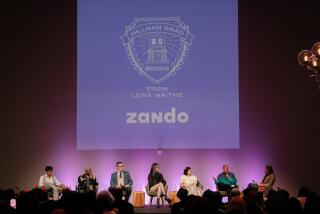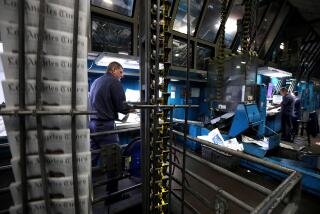A Master Printer to Leave Lasting Impression Behind
- Share via
John Randle, the tall, rangy proprietor of the distinguished Whittington Press in the west of England, is impressed with the amount of private presses and the quality of their work in Southern California--Ward Ritchie’s in Laguna Beach for one.
“I’m afraid most people aren’t aware that this area has become a world center, in fact, a key area, of private presses. The booksellers and collectors are here in numbers to encourage fine printing,” he told me the other day.
Randle is serving as Visiting Nixon Scholar at Whittier College, where he is initiating 11 students into the pleasures and disciplines of letterpress printing. The college now owns an 1860 Columbian hand press, along with two Vandercook proof presses. He hopes these presses and nearly 200 pounds of 14-point Caslon type (Randle’s favorite typeface) that he brought to Whittier from England will herald the beginning of a continuing Whittier College press when he leaves after Feb. 2.
He will leave behind not only the type he cast on his Monotype machine in his country print shop at Andoversford, Gloucestershire, but a maiden legacy of fine letterpress printing in the form of a 16-page book on handmade English paper.
The book will be a series of 50 letters from T. E. Lawrence, the legendary Lawrence of Arabia, to his longtime friend, E. T. Leeds. Also included will be a memoir of Lawrence by Leeds, written in 1938. The letters and the memoir have never been published. Randle obtained the manuscripts from Leeds’ nephew. A limited edition of 750 will be published by the students.
“I’m delighted by the way they’re working and the work is fine,” he said, adding that he literally has to kick the students out of the shop at night because they have become so engrossed in their project. None of them had ever hand-set type before, nor had they an appreciation of the lovely sculptural quality that can result from printing with metal type on handmade, dampened paper.
Randle, whose Whittington Press is strictly a letterpress operation, is optimistic about the future of letterpress printing as both a handicraft and an art form. Although computer typesetting and photo-offset printing have virtually superseded the metal letterpress printing as an essentially commercially viable enterprise, Randle believes that letterpress will survive in the private presses because it is a craft--like potting, weaving and wood engraving--that demands a high degree of hands-on skill and knowledge to do well. The challenge to create a beautiful object with the best of materials by fairly simple, direct means in part accounts for letterpress’s appeal.
“Until the computer and photo-offset catches up typographically--if it it ever does--letterpress will be with us for a long time,” he said. “Of course it is slower, but better typographically, and there is a tremendous fallout of good material we can publish letterpress. We’ll just leave the sterile stuff to the computers.”
Randle points to the growing establishment of college and university presses, devoted to the 500-year-old art and craft of printing with metal type, as indicative of letterpress’s cultural and academic value. Scripps and Mills colleges both have solidly established presses, Pomona College is buying old equipment, USC is establishing its press, the University of California has a well-established press, and now Whittier College has a press.
In 15 years since their press was founded, Randle and his wife, Rosalind, have succeeded in becoming one of England’s leading fine printers. With five or six books published per year, in addition to press ephemera and a fine printing magazine called “Matrix,” the Whittington Press now has more than 100 published books to its credit.
And all in the old-fashioned, slow way that I dare say is here to stay in spite of leapfrogging technology, thank goodness.
More to Read
Sign up for our Book Club newsletter
Get the latest news, events and more from the Los Angeles Times Book Club, and help us get L.A. reading and talking.
You may occasionally receive promotional content from the Los Angeles Times.







